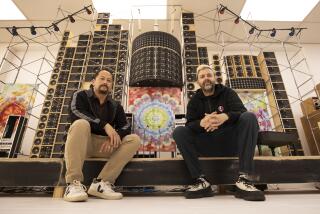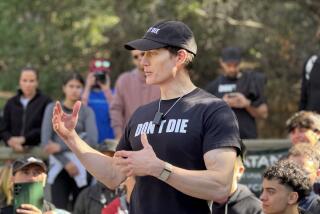A Hunk of Burninâ Love on a Chain : Weird science: Nobel laureate Kary Mullis has a new âdiscoveryâ for us--jewelry that preserves the DNA of Elvis . . . and lots of other dead folks.
If Nobel laureate Kary Mullis has his way, the number of Elvis sightings will increase dramatically in the next few years. And the question of whether the King is alive or dead will become even muddier than it is today.
Mullis has bought the rights to extract a smidgen of DNA from a lock of Presleyâs hair. Using a âgene amplificationâ technique that he invented--an ingenious DNA duplicating system that won him the 1992 Nobel Prize in chemistry--Mullis will make millions of copies of Presleyâs genes and preserve these minuscule globs inside artificial gemstones, to be made into a line of necklaces, earrings and other collectibles.
For the record:
12:00 a.m. Oct. 26, 1995 For the Record
Los Angeles Times Thursday October 26, 1995 Home Edition Life & Style Part E Page 4 View Desk 2 inches; 41 words Type of Material: Correction
DNA rights--An Oct. 19 story in Life & Style on celebrity DNA stated that Kary Mullis had bought the rights to extract DNA from a lock of Elvis Presleyâs hair. The Estate of Elvis Presley has not licensed the rights to Mullis; he purchased the rights to extract the DNA from hair owned by a third party.
Elvis wonât be the only superstar to be genetically rejuvenated. Mullisâ company, called Stargene, has quietly gained rights to hair samples snipped from scores of celebs, including Marilyn Monroe, Abe Lincoln, Geronimo, James Dean and Albert Einstein. Even the nationâs first First Couple, George and Martha Washington, are due to have their DNA revived by Stargene in time for the 1996 elections.
Jurassic Celebrity Park? Not quite. Mullis plans to propagate only a small fraction of each starâs total biological blueprint, so complete resurrections are not to be feared. Marilyn wonât be singing âHappy 79th Birthdayâ to JFK. Albert wonât explain to Abe the relativistic reality of being hit by a speeding bullet. Each trinket will contain just a handful of the starâs genes, taken from whatever body part Mullis can get his hands on--usually hair.
Not everyone feels a calling to sell microscopic bits of dead people as fashion accessories. But Mullis, 50, is at home on the fringe. He is a hard-drinking, thrice-divorced surfer and self-avowed connoisseur of psychedelic drugs who is renowned for including colorful images of naked women in his slide presentations at scientific meetings.
Recently Mullis has taken the unorthodox position that the human immunodeficiency virus, HIV, does not cause AIDS. He was listed as a witness for the defense in the O.J. Simpson trial but wasnât called because of fears that revelations about his lifestyle would undermine his credibility. So itâs not surprising that some people view Stargene as just the latest product of an irreparably warped mind.
âThere are those who say the idea is grotesque and those who say itâs beautiful,â Mullis said from his 300-acre ranch in Mendocino on the rugged Northern California coast. âWell, one manâs floor is another manâs ceiling. And whether it grosses someone out or not, the idea sure has an effect on people.â
The main effect Mullis is hoping for is a sudden desire among otherwise civilized people to shell out about $100 each for reconstituted pieces of their favorite cultural icons, and to wear those microscopic specimens around their necks or hang them from their ears in jeweled carrying cases. And why not?
Probably lots of students would feel better going into a final exam with a handful of Einsteinâs genes. Preliminary market surveys by Stargene, based in San Rafael and founded by Mullis with half a million dollars of start-up money from private investors, indicate that celebrity DNA is a $100-million business waiting to happen.
Not everyone believes thereâs gold in them thar cells.
âWhen someone says to me, âI have a piece of Mick Jagger with meâ and they show me DNA from a cell culture, my reaction is, âIt doesnât sing well, so who cares?â â said Arthur Caplan, head of the University of Pennsylvaniaâs Center for Bioethics.
But even Caplan sees how DNA-laden trinkets just might take off. âMagical thinking about the body runs deep in Judeo-Christian culture,â he said. Consider the old relics from the Catholic church, or the elegant Victorian lockets designed to hold a sample of a loverâs hair.
âWe think we can gain power, strength or other characteristics by having a piece of someone we admire on our person.â
The idea for Stargene came to Mullis a few years ago while he was partying with some biochemists in New Orleans. His DNA duplication process--known as polymerase chain reaction, or PCR--was already popular with researchers and cops because it could make so much DNA from so little, a prerequisite for tracking down cancer genes and criminals.
But Mullis was thinking on a different scale.
âI was talking about selling dinosaur DNA,â he recalled. âAnd somebody said, âWhat about Elvis Presley?â We started talking about it, and everybody realized there was a real possibility that something like that could work.â
*
Stargene is still hammering out the final design and production details, with hopes of hitting the stores next spring. But the company has a pretty good idea of what the product will look like.
âWeâll probably start with a line of upscale, tastefully done dog tags that hang on a chain,â said Robert N. Harris, Stargeneâs chief operating officer. âPewter or gold plate.â The DNA itself is sealed in a transparent, synthetic gemstone about half an inch in diameter--dubbed a Genestone--that the company has been perfecting. Although the DNA itself is too small to see, it is suspended in the stone in a cloudy liquid. âIt looks like youâre looking at the Milky Way,â Harris said.
Bracelets, brooches and earrings are also being designed.
Then there will be what Stargene calls âthe framed collectible memoir line.â
The plan is to start with a Founding Fathers Collection featuring pictures--and Genestones--of Washington, Jefferson and the rest, and a history of how the DNA was acquired.
And where does one get a hair from a founding father these days? Enter John Reznikoff, a 35-year-old manuscript collector and president of University Archives in Stamford, Conn. Reznikoff owns what is probably the worldâs largest collection of authenticated tresses, featuring head hair from Lincoln, Napoleon Bonaparte, Charles Lindbergh, Franz Liszt and close to 100 other historical figures.
Last month, Reznikoff and Stargene announced they had entered into a partnership that will make tiny bits of these hair samples available to Mullis to create what will amount to DNA âstarter cultures,â whence can be grown infinite copies of genes to be placed inside infinite numbers of Genestones.
*
But what about the rights to actually sell those genes with a personageâs name? âIt opens the door to a serious question of ownership of biological materials,â Caplan said.
The courts, it turns out, have said little about the legal intricacies of selling such molecular memorabilia. And some descendants of those stars who are about to be freshly immortalized may prefer that their forebearsâ genes be allowed to rest in peace.
The question is simple: To what extent do people (or their offspring or estates) own rights to those parts of their bodies that have quietly and humbly fallen by the wayside?
But at what point does cellular scavenging become body snatching?
âThere is still a great deal of argument and confusion about the property status of biological samples,â Caplan said. âAnd I think that canât go on much longer. Thereâs a slew of people who may become the next generation of DNA autograph seekers. . . . Why collect ink when you can collect biological signatures?â
Mullis says he has no intention of expropriating peopleâs genes; if a starâs offspring or estate wants a cut of the action, there is always the possibility of a royalty arrangement. And the company is considering paving the way to public acceptance with some âgoodwillâ ventures: perhaps a collaboration that would benefit an environmental group by selling collectibles containing genes from endangered species. Or a deal with Mickey Mantleâs estate to make baseball cards containing the sluggerâs genes, to benefit the organ transplant fund he established near the end of his life.
More to Read
Sign up for Essential California
The most important California stories and recommendations in your inbox every morning.
You may occasionally receive promotional content from the Los Angeles Times.










